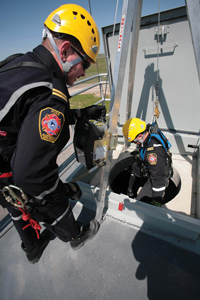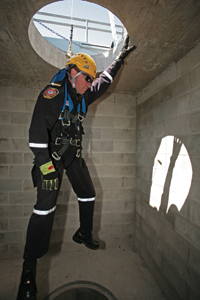
Features
Codes and standards
Hot topics
Best Practices: December 2010
A new standard that defines confined spaces and provides guidelines to help rescuers avoid potential risks is expected to reduce the number of confined-space deaths in Canada. The Canadian Standards Association (CSA) recently released CSA Z1006 Management of Work in Confined Spaces, a national standard that has implications for firefighters and first responders.
November 25, 2010
By Rosie Lombardi
A new standard that defines confined spaces and provides guidelines to help rescuers avoid potential risks is expected to reduce the number of confined-space deaths in Canada.
The Canadian Standards Association (CSA) recently released CSA Z1006 Management of Work in Confined Spaces, a national standard that has implications for firefighters and first responders.
 |
|
| Firefighters at the Greater Toronto Airports Authority’s Fire and Emergency Services Training Institute practise confined-space rescue. The recently released CSA Z1006 Management of Work in Confined Spaces defines a confined space and provides guidelines for managers, workers and rescuers. Photo by John Riddell |
“This new CSA standard, the first of its kind in Canada, defines what a confined space is and provides guidelines to managers, workers and rescuers for identifying and avoiding potential risks while not becoming victims themselves,” says CSA president Suzanne Kiraly.
Confined spaces can be found in almost all industries and include grain and corn silos, hydro vaults, underground tunnels, shipping compartments, pump stations, boilers and chemical tanks. Workers in these environments are at risk of serious injury or death resulting from asphyxiation, engulfment, electric shock and other causes.
More than 60 per cent of confined-space fatalities are would-be rescuers, according to the CSA. These would-be rescuers are often fellow workers, but the statistic also includes firefighters and first responders who succumb to the same environmental hazards.
“In Canada, there has been an increase in the number of confined-space incidents involving firefighters over the past decade,” says Christopher Jones, Manitoba’s fire commissioner.
In British Columbia alone, 18 deaths related to confined spaces were recorded between 1989 and 2004; five of those deaths were people trying to rescue the original victims. Unfortunately, these incidents aren’t tracked nationally, so there are no Canada-wide statistics available.
Doug Silver, division chief for Toronto Fire Services, says there have been no fatalities due to confined-space rescues in the Greater Toronto Area during his 20-year tenure, but there have been many close calls.
“People call the fire department because we’re the jacks of all trades,” he says. “Firefighters will do their best, but the question is, are we sending untrained or unequipped firefighters to do things that are beyond their capabilities?”
How the standard helps
Firefighters are in a dependent and precarious position. They rely on industry to put measures in place to reduce the hazards in their workplaces and to educate their workers about how to handle incidents, says Jones.
“We’re in an industry where it’s incumbent on rescuers to stay current. With the CSA standard, firefighters need to know the parameters of people working in confined spaces and how to respond if people make a mistake.”
Because CSA Z1006 is a national standard with a set of associated best practices, Silver says it will bring consistency across Canada. “It’s my understanding that not every province had a standard that defined confined-space working conditions under their Occupational Health and Safety Acts (OHSA). A national standard brings all industry to a similar level when it comes to dealing with confined spaces. It sends the message to industry: You need to prepare yourself before firefighters get there because they may not get there in time if there’s an accident.”
As with any new standard, it takes time for industry to implement changes, Silver adds. “But since it’s under the OHSA, it has teeth. If companies don’t do the right thing, management will be fined or jailed, so there’s a lot of onus put on industry to follow it.”
Companies have already been hit with hefty fines for violations in Ontario, which had strict rules in place under its OHSA. In 2007, Bell Canada was fined $280,000 in the deaths of two men – the largest fine given to a federally regulated company for Canada Labour Code violations. The two men died in an Oakville underground vault while installing fibre-optic cables for Bell. They were about five metres below ground when they were overcome by toxic fumes. By the time firefighters pulled them out, they were dead.
Worker awareness and education is critical to ensure the best and fastest rescue response, as many such emergencies are due to toxic atmospheric factors, says Silver. “The best way to trigger the right response is if workers know to say confined space when they call in an incident to dispatch. If they just call and say a co-worker slipped and broke a leg, it will be read as a medical call and pumpers will be sent. But if the medical emergency happened in a confined space, we’ll send a specialized operations squad with the right equipment and experts.”

|
|
| Workers in almost every industry are at risk of confined-space related injury or death. The standard will bring consistency across Canada and will help industry prepare for confined-space emergencies so rescuers can respond as efficiently as possible. It will also reduce the number of fatalities and close calls. Photo by John Riddell |
Time is of the essence in these situations, says Silver. Pumpers that get to the scene first will call the squad and do the best they can in the meantime, but they may not have the right equipment to handle the rescue safely themselves.
Toronto has five strategically located specialized operations stations with the best equipment and staff to handle any hazard, but it can take from five to 15 minutes for them to get to the scene, he adds. “If the squad isn’t called right away, you’ve lost precious time. If it’s an atmospheric incident, 15 minutes may be outside the window of survivability.”
Dispatchers and 911 operators also need to be aware of confined-space issues, says Jones. In Manitoba, industry is well educated about confined spaces but not all of these incidents occur in industrial settings.
“Dispatchers need to be asking the right questions when the call comes in, as incidents are not always what they appear to be. If a kid falls down a well and mom calls, she won’t know to say it’s a confined-space incident – but it will require a specialized, confined-space rope rescue.”
Most emergency rescue personnel are keen to keep on top of their training, and dispatchers generally do a good job of deducing confined-space incidents from panic-stricken callers. “We recently ran a conference that had 450 people in attendance, and we’ve also run confined-space awareness programs throughout the years,” says Jones, adding that the Manitoba Emergency Services College is run under his office, and offers national training and 29 programs at its 60-acre practical training site.
Confined-space rescue equipment and training is expensive, and there may be issues for smaller fire departments that serve cash-strapped municipalities, says Silver. “Their mandates are determined by city councils or authorities for the region. These may decide the only thing the fire department will handle is fires and spend money only on that, so confined space rescues may not be funded. But the fire department must nevertheless respond to such incidents.”
However, there are pockets of expertise for technical rescues even in small municipalities if a specific hazard exists in the area, he adds. “If there’s recreational cliff climbing in the region, for example, fire departments will have to respond if there are incidents. They can go to the council and ask for funding if confined spaces are identified as a hazard in the community.”
Over time, the CSA standard will help save lives, and fire departments should be involved in outreach, says Jones. “It’s important that industry and emergency responders begin a dialogue about confined spaces and look at joint training and other steps that would help solidify measures. Most fire departments do pre-planning with the businesses in their municipalities. They need to keep that going and get out there and do sessions for industry so they know what their rescue procedures are and how they work.”
Rosie Lombardi is a Toronto-based freelance writer and regular contributor to Fire Fighting in Canada.
Print this page